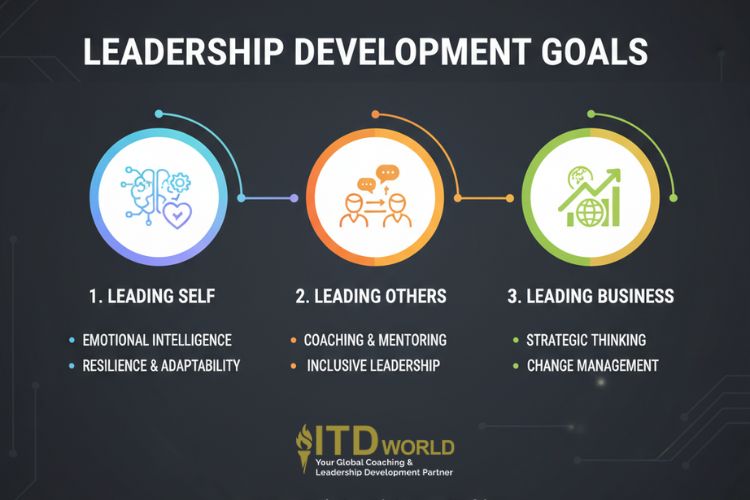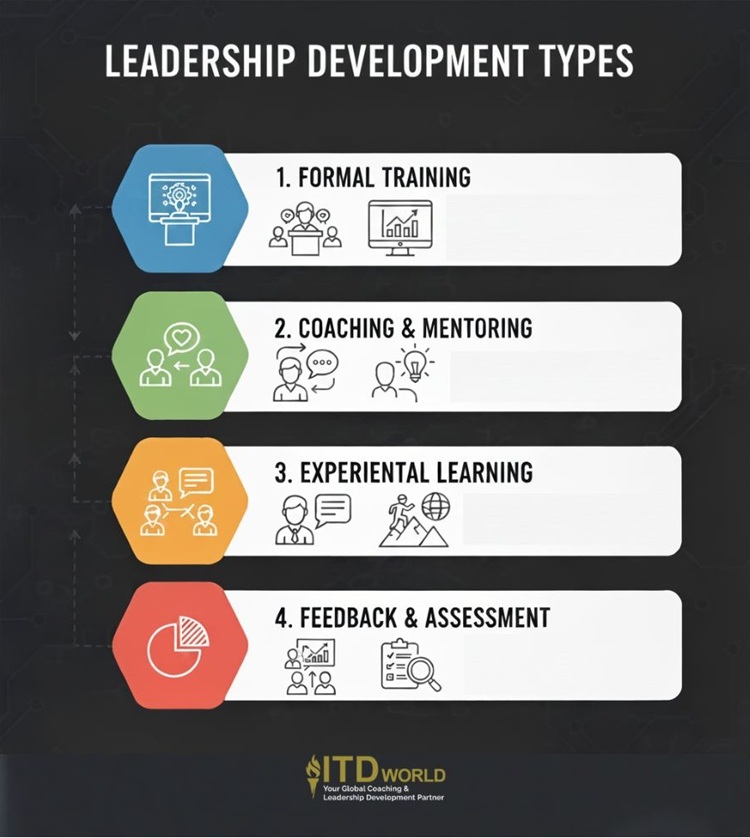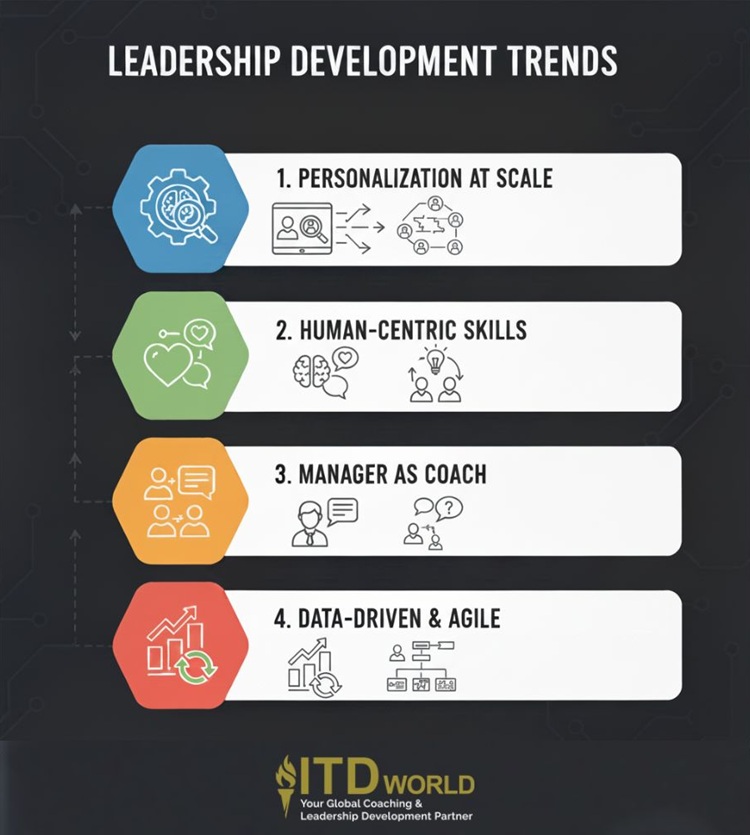An extensive framework for designing and implementing a high-impact leadership development strategy that drives tangible ROI.
The rapid advancements in AI, widespread digital transformation, and continuous market volatility are quickly rendering many traditional management skills inadequate. To thrive amidst these changes, organizations must view leadership development as a mission-critical function, not a discretionary perk. It’s the engine that fosters the agility, resilience, and innovative thinking essential for navigating uncertainty and securing a sustainable competitive advantage.
|
Author: Jonathan M. Pham |
Highlights
- Leadership development is a systematic, continuous process that enhances the skills, abilities, and confidence of leaders at all levels to improve current performance and prepare them for future responsibilities, all while aligning with the organization’s strategic objectives.
- Investing in leadership training is crucial for organizational success in the age of AI and disruption, as it cultivates essential human skills, attracts and retains top talent, and mitigates the significant risks associated with a weak management pipeline.
- Effective leadership development programs offer a holistic approach, focusing on Leading Self (emotional intelligence, resilience), Leading Others (coaching, psychological safety, inclusive leadership), and Leading the Business (strategic thinking, change management) to equip leaders with the capabilities to navigate complexity and drive organizational success. Various methods may be utilized, including formal training (workshops, courses), personalized coaching and mentoring, experiential learning (real-world application), and feedback/assessment tools.
- A high-impact leadership development program requires a three-phase approach: PLAN by aligning with business goals, identifying audience needs, and defining success metrics; EXECUTE by creating personalized learning journeys and securing senior leadership buy-in; and MEASURE & REFINE by using a balanced scorecard, gathering qualitative feedback, and iterating for continuous improvement.
- Many leadership development plans fail due to an “event mindset,” a lack of senior leadership buy-in, and a disconnect from real-world business needs.
- The future of leadership training will be characterized by hyper-personalization at scale through AI, a deeper focus on human-centric skills like emotional intelligence, the rise of managers as coaches, and data-driven, agile program design to ensure continuous improvement and relevance.
What is Leadership Development?
Leadership development (also referred to as leadership training) is the systematic and continuous process of enhancing the skills, abilities, and confidence of leaders at all levels – from emerging supervisors to senior executives. Its purpose is to improve their performance in their current roles – and to prepare them for future responsibilities, all in direct alignment with the organization’s overarching objectives.
Key aspects:
- Systematic and continuous: This is what separates strategic leadership development from random, one-off training events. It is not a single workshop, but an ongoing, intentional process that is woven into the fabric of the organization.
- At all levels: A healthy organization understands that leadership exists everywhere and therefore is dedicated to developing its entire leadership pipeline, from first-time managers to seasoned VPs – not just the C-suite.
- Alignment with strategic goals: Leadership training is not about teaching generic skills; it is about cultivating the specific capabilities the organization needs to execute its unique strategy and win in its market.
Example: A company whose target is to expand into new international markets would design a program focused on cross-cultural communication, managing remote teams, and navigating global business complexity. This is fundamentally different from a business aiming to foster rapid product innovation, which would instead focus on developing leaders who can foster psychological safety and lead agile teams. The strategy dictates the execution.
The Importance of Leadership Development
The single biggest way to impact an organization is to focus on leadership development.
- Thriving in the Age of AI & disruption
As technology and AI automate routine technical tasks, uniquely human leadership skills become more desirable than ever. A recent report by McKinsey & Company highlighted that the demand for qualities like critical thinking, creativity, and complex problem-solving is set to soar.
An investment in leadership development is an investment in the very capabilities that cannot be automated – the ability to lead teams, drive innovation, and navigate change in an increasingly complex world.
- Winning the war for talent
In today’s competitive talent market, professional development initiatives provide a powerful tool for attraction and retention. Research from Gallup consistently shows that opportunities to learn and grow are among the top priorities for employees, especially for Millennial and Gen Z workers.
When individuals see a clear path for advancement and believe the company is invested in their future, their engagement and loyalty increase dramatically – which in turn translates to a lower turnover rate (and therefore a reduction in operational costs).
- The high cost of inaction: A weak leadership pipeline
Perhaps the most compelling reason to invest is the immense risk of not doing so. A failure to cultivate leaders from within creates a fragile organization vulnerable to market shifts. Various studies have revealed that a significant number of companies report that they have a weak leadership pipeline – or are not confident that their leaders have the necessary skills to meet future business challenges.
Example: For decades, General Electric (GE) was considered the gold standard for producing world-class leaders. However, many business analysts have partly attributed the company’s later struggles to a decline in the strength of its famed leadership development “factory.” This serves as a powerful reminder that even the most successful companies can falter when they neglect the crucial function of systematically cultivating their next generation of leaders.
The evidence is overwhelming: the question is no longer IF an organization should invest in leadership training, but HOW it can afford not to.

Leadership Development Goals & Topics
Effective, modern programs move beyond traditional management training to impart a holistic set of capabilities that enable participants to navigate complexity with grace and confidence. Generally speaking, these should cover three distinct but interconnected domains: Leading Self, Leading Others, and Leading the Business.
-
Leading Self: The foundation of personal effectiveness
All great leadership begins with self-leadership. Before one learns to guide others, they must first master their own mindset and behaviors.
Key topics:
- Emotional intelligence & self-awareness: The ability to understand one’s own emotions, strengths, and weaknesses, as well as to perceive how one’s behavior impacts others. This is the bedrock of effective leadership.
- Resilience & adaptability: The capacity to navigate high-pressure situations, bounce back from setbacks, and thrive in an environment of constant change and ambiguity.
-
Leading Others: Inspiring & empowering teams
The second domain focuses on the critical interpersonal skills needed to build engaged, innovative, and high-performing teams.
Key topics:
- Coaching & mentoring: Shifting from the role of a “director” who gives answers to that of a “facilitator” who asks powerful questions, so that team members may realize their own potential.
- Fostering psychological safety: The ability to create an environment where team members feel safe to speak up, share ideas, raise concerns, and take smart risks without fear of blame or reprisal.
- Inclusive leadership: The skill of leveraging the full power of diverse teams by ensuring every voice is heard, valued, and respected, leading to better decisions and a stronger sense of belonging.
-
Leading the Business: Driving strategic success
This domain connects leadership skills directly to tangible business outcomes and ensures leaders are making decisions that move the entire organization forward.
Key topics:
- Strategic thinking & business acumen: The ability to see the “big picture,” understand market dynamics and financial drivers, and come up with strategies that align with the company’s long-term strategic goals.
- Change management: Effectively guiding teams through organizational transformations – such as new technology rollouts, restructures, or strategic pivots – with clarity, empathy, and purpose.

Types of Leadership Development
- Formal training (workshops and courses): Structured learning experiences, delivered either virtually or in-person, designed to cultivate foundational knowledge and introduce new concepts and frameworks in a consistent manner. It is excellent for efficiently teaching core principles and providing a shared language for a group of leaders.
Example: A formal workshop on Change Management could introduce a cohort of leaders to an established model like Kotter’s 8-Step Process, providing everyone with a common framework to use back on the job.
- Personalized coaching & mentoring: A confidential, one-on-one partnership with a trained expert to address one’s unique challenges and goals.
- Experiential learning (learning by doing): Based on the principle that adults learn best by applying new skills to real-world challenges, it moves leadership development out of the classroom and into the business.
Example: An action learning project, where a small group of leaders is tasked with solving a real, complex business problem. Or, one may consider giving a high-potential leader a “stretch assignment,” such as leading a cross-functional initiative outside of their core area of expertise.
- Feedback & assessment: Leveraging structured tools (e.g. 360-degree assessment) to provide objective, data-driven insights into one’s current skills, behaviors, and impact on others. It fosters the self-awareness needed for a leader to realize their strengths and identify their most critical development opportunities.

A Blueprint for a High-Impact Leadership Development Program
The difference between a leadership development initiative that is a forgotten “perk” and one that is a true “strategic investment” lies in its design, execution, and measurement. For those looking to deliver a high-impact program, you can consider following the 3-phase process below:
-
PLAN: Designing your strategic foundation
The initial phase is the most critical, as it ensures that your plan addresses real business needs – and that its success can be clearly measured.
- Align with business goals
The first and most important question to answer is: “What key business challenges are we trying to solve?” A world-class program must be directly linked to the organization’s top strategic priorities, whether that is driving innovation, improving operational efficiency, or expanding into new markets.
- Identify your audience and needs
Before designing any content, you must understand your audience. This involves conducting a thorough Training Needs Analysis (TNA) to figure out the specific skill gaps and development needs of your target leaders.
Example: A TNA might reveal that your newly promoted managers are struggling with delegation, while your senior directors need to enhance their change management skills. Knowing this would allow you to come up with targeted, relevant initiatives for each cohort instead of a one-size-fits-all approach.
- Define success metrics
It is crucial to define what success looks like before you begin – by establishing clear Key Performance Indicators (KPIs) that can be tracked over time.
Example: A clear success metric might be “to increase the internal promotion rate for key roles by 15% within two years” or “to improve employee engagement scores on the teams of participating leaders by 10%.”
-
EXECUTE: Delivering a world-class experience
Moving to the second stage, it’s time to make your strategic plan come to life through engaging, relevant, and applicable learning experiences.
- Create personalized learning journeys
The most effective programs utilize a “blended learning” approach – i.e. a rich learning journey that combines the different methods from the “Toolkit,” such as formal workshops, one-on-one coaching to reinforce learning, and experiential “action learning” projects where participants apply their newly acquired competencies to a real business problem.
- Secure senior leadership buy-in
A program’s success depends significantly on the visible support of the executive team – whose role is to act as champions for the initiative. This can be achieved by having a senior executive kick off the program, participate in a panel discussion with the cohort, or serve as mentors for participants.
-
MEASURE & REFINE: Ensuring a Return on Investment (ROI)
This crucial final phase closes the loop, proves the program’s value, and drives continuous improvement.
- Use a Balanced Scorecard
To measure impact, one should track both leading indicators (e.g., participation rates, course completion data, and participant satisfaction scores) as well as the lagging indicators defined in the planning phase (e.g., improvements in employee retention, team performance, and internal promotion rates).
- Gather qualitative feedback
When it comes to soliciting feedback, make sure to go beyond the numbers to truly understand the participant experience. Use surveys, interviews, and focus groups to gather stories and testimonials about how the learning has been applied on the job.
- Iterate & improve
After analyzing the data & input gathered to come up with insights, it’s time to leverage them to continuously refine and enhance your leadership development program for future cohorts, ensuring it remains relevant and impactful over time.
Read more: Employee Development Plan – Fueling Future Success

Stages of leadership development
Challenges of Leadership Development
Despite good intentions and significant investment, many leadership development programs fail to deliver their expected impact. They are often seen as a costly expense with little demonstrable return, leading them to be the first items cut during a budget review.
However, these failures are not random; they are typically caused by a set of pitfalls as follows:
- Treating development as an “event” instead of a process
The most common mistake is the “event mindset” – sending leaders to a two-day workshop and expecting lasting behavioral change. Without reinforcement, the initial enthusiasm and learning quickly fade as leaders return to their daily pressures.
Solution: Design a continuous learning journey – one that involves reinforcement mechanisms to ensure learning is transferred back to the workplace.
Example: A program should be structured to include pre-work to set the stage, the workshop itself to introduce concepts, and – most importantly – post-workshop activities (e.g. group coaching sessions to discuss application challenges, a real-world action learning project, and structured follow-up conversations with the leader’s manager to ensure they are supporting the new behaviors).
- Lack of senior leadership buy-in & role-modeling
A training plan is destined to be perceived as unimportant if senior leaders treat it as something for “other people” but not for themselves. A lack of visible executive sponsorship sends a powerful message that the initiative is not a strategic priority.
Solution: Make senior leaders your most visible champions. Their active participation is non-negotiable.
Example: When a CEO or a respected executive personally kicks off a leadership program and shares their own development journey and leadership challenges, it causes a massive impact on participant engagement. Furthermore, when senior leaders act as mentors or sponsors for the program’s cohort, it deeply integrates the initiative into the organization’s culture.
- Disconnect from real-world business needs
Training is doomed to fail if it only concerns generic, abstract theories that are not directly applicable to the specific, pressing challenges the organization is facing. When participants cannot see the immediate relevance to their work, they WILL disengage.
Solution: Deeply contextualize the learning content to solve the company’s real issues.
Example: Instead of a generic module on “strategy,” a training program should be built around a case study directly from the company’s own market or a key competitor. The participants should work on solving a genuine business problem the organization is currently facing.
Future Trends in Leadership Development
As organizations look to future-proof their talent, several key trends are emerging that will define the next generation of high-impact leadership programs.
- Hyper-personalization at scale
The era of the “one-size-fits-all” leadership workshop is coming to an end. Given the emergence and rising influence of Artificial Intelligence (AI), the future of learning and development is about delivering highly personalized journeys tailored to each individual’s specific needs, role, and career aspirations.
In practice: AI-powered Learning Experience Platforms (LXPs) will curate unique development paths for each leader. Based on their current skills (identified through assessments) and stated goals, a mid-level manager might automatically receive micro-learnings on delegation, while a senior director is served content on leading global teams – all delivered in the flow of their daily work.
- A deeper focus on “human-centric” skills
Paradoxically, as technology and AI automate more analytical and routine tasks, the most critical leadership skills are becoming more human. In other words, the leader’s primary value is shifting to areas that technology cannot replicate.
The shift: Future-focused training programs are moving beyond technical management processes to cultivate deep capabilities in emotional intelligence, empathy, creative problem-solving, and fostering psychological safety. These are what differentiate effective human leaders in an increasingly automated world.
- The rise of the “manager as coach”
Organizations are recognizing that professional development shouldn’t only happen during formal training programs. The trend is to promote a true coaching culture by equipping every manager with fundamental coaching skills.
In practice: This transforms the role of the manager from a “director” of tasks to a “facilitator”. Instead of just giving feedback once a year, managers are trained to hold regular coaching conversations regarding their team members’ growth, career aspirations, and problem-solving skills, turning every one-on-one into a powerful development opportunity.
- Data-driven & agile development
The approach to designing training plans is becoming more like modern software development: agile, iterative, and informed by real-time data. Instead of launching large, multi-year programs and only measuring success at the end, organizations are using data to make rapid adjustments.
In practice: This involves conducting frequent pulse surveys and analytics from learning platforms to see which interventions are producing the most impact. If a particular module isn’t resonating or a skill gap isn’t closing, the learning and development team can quickly pivot and redesign the experience, ensuring that resources are always deployed in the most effective way possible.

Leadership Development Plan Template
Introduction: Your Roadmap for Growth
This Leadership Development Plan (LDP) is a practical tool designed to help you intentionally manage your growth as a leader. It provides a structured framework for moving from self-reflection to clear, actionable goals.
Use this document to create a personalized roadmap for developing the skills, abilities, and confidence you need to excel in your current role and prepare for future challenges. A well-crafted LDP is a living document—your personal commitment to continuous improvement.
Section 1: Self-Assessment & Reflection (Where Am I Now?)
Before setting goals for the future, take a moment to honestly assess your present standing. Consider feedback from your manager, peers, 360-degree assessments, and your own reflections.
My 2-3 Core Strengths to Leverage:
(What are the leadership skills that currently serve me and my team well?)
1.
2.
3.
My 1-2 Key Development Opportunities:
(What is the most impactful area where improving my leadership skills would make the biggest difference for me and my team?)
1.
2.
My Career Aspirations (Next 1-3 Years):
(What role or level of impact am I aiming for? What skills will I need to get there?)
Section 2: Defining Your Development Goals (Where Am I Going?)
Based on your reflection, create 1-2 specific and measurable (SMART) goals across the three key domains of leadership. These will be the “what” you want to achieve.
Domain 1: Leading Self (e.g., Resilience, Emotional Intelligence, Self-Awareness)
Goal 1:
Domain 2: Leading Others (e.g., Coaching, Communication, Fostering Psychological Safety)
Goal 2:
Domain 3: Leading the Business (e.g., Strategic Thinking, Change Management, Business Acumen)
Goal 3:
Section 3: Creating Your Action Plan (How Will I Get There?)
This is the most critical part of your plan. For each goal you defined above, outline the specific actions you will take, the support you need, and how you will measure success.
| Development Goal (from Section 2) | Development Actions / Methods (e.g., Formal Training, Coaching, Experiential Learning, Self-Study) | Resources / Support Needed (e.g., Manager’s approval, budget, a mentor) | How I Will Measure Success (e.g., Improved 360 score, positive team feedback) |
| Example: Improve my coaching skills to better develop my team. | 1. Enroll in a certified coaching workshop.2. Practice the GROW model in my weekly one-on-ones.3. Read “The Coaching Habit.” | Budget for workshop approval from my manager. | Team survey shows a 10% increase in “opportunities to grow.” |
| Goal 1: | |||
| Goal 2: | |||
| Goal 3: |
Section 4: Accountability & Follow-up
A plan without accountability is just a wish. Commit to a review process to stay on track.
My Accountability Partner will be:
(This could be your manager, a mentor, or a professional coach.)
Review Schedule:
(How often will you review this plan with your accountability partner?)
Example: I will review this LDP with my accountability partner on a [monthly/quarterly] basis.

Leadership Development Quotes
Check out more training quotes here!
The function of leadership is to produce more leaders, not more followers.
Ralph Nader
As more and more artificial intelligence is entering into the world, more and more emotional intelligence must enter into leadership.
Amit Ray
We are no longer in the dispensation of age and experience. We are in the era of knowledge and information. Information leads a true leader and a true leader leads others.
Israelmore Ayivor
Leadership Development Books
- The 21 Irrefutable Laws of Leadership by John C. Maxwell: A foundational guide that outlines 21 essential principles every leader should master – plus actionable laws like “The Law of Influence” and “The Law of Legacy”.
- Good to Great by Jim Collins: Based on a five-year research project, the book explores why some companies make the leap from good to exceptional – and how leadership plays a pivotal role. It introduces concepts like the “Hedgehog Concept” and “Level 5 Leadership”.
- Start with Why by Simon Sinek: Sinek argues that great leaders inspire action by clearly communicating their “why” – their purpose or belief. His work is a rallying cry for purpose-driven leadership that motivates teams from the inside out.
- Leaders Eat Last by Simon Sinek: Drawing from military and corporate examples, Sinek discusses how leaders who prioritize their people create safer, more trusting, and more productive environments.
- The Oz Principle by Roger Connors, Tom Smith, and Craig Hickman: A practical guide to accountability in leadership. It encourages leaders to “See It, Own It, Solve It, and Do It” to drive results and foster a culture of ownership.
- The Energy Bus by Jon Gordon: Presented as a fable, the book outlines 10 rules for infusing your life and management with positivity and purpose. It’s a light, energizing read with a big impact.
- Influence Without Authority by Allan R. Cohen and David L. Bradford: Perfect for emerging leaders, the book teaches how to lead and influence even when you don’t have formal power – through collaboration, trust, and strategic persuasion.
Discover ITD World’s Leadership Development Programs
At ITD World, we specialize in partnering with organizations to build and sustain a pipeline of future-ready leaders. We provide end-to-end solutions that support every phase of the leadership development lifecycle, ensuring your investment yields tangible and lasting results.
Our integrated solutions are designed to help you:
- Plan with clarity and purpose: We partner with you to conduct a comprehensive Training Needs Analysis (TNA), helping you identify critical skill gaps and design a strategy that serves your unique business goals.
- Execute with impact: We design and deliver customized training programs and certificate courses that impart the essential skills your leaders need – from strategic thinking and change management to AI literacy and inclusive leadership.
- Reinforce and sustain learning: We believe that learning must be applied to be effective. As such, we provide world-class executive coaching and mentoring certification programs to ensure that newly acquired competencies are transferred back to the workplace and reinforced over time.
- Measure for success: Our powerful assessment tools are designed to closely measure progress, demonstrate the tangible ROI of your programs, and drive continuous improvement.
Ready to build a pipeline of future-ready leaders who can drive your organization forward? Contact ITD World today to see how we can help!
Other resources you might be interested in:
- 12 Leadership Coaching Topics to Drive Lasting Transformation
- Leadership Excellence: Moving From Manager to Multiplier
- Situational Leadership: Guide to Implementation
- Transformational Leadership: Inspiring Change & Growth
- Leadership Philosophy: How to Define Your True North & Follow It

